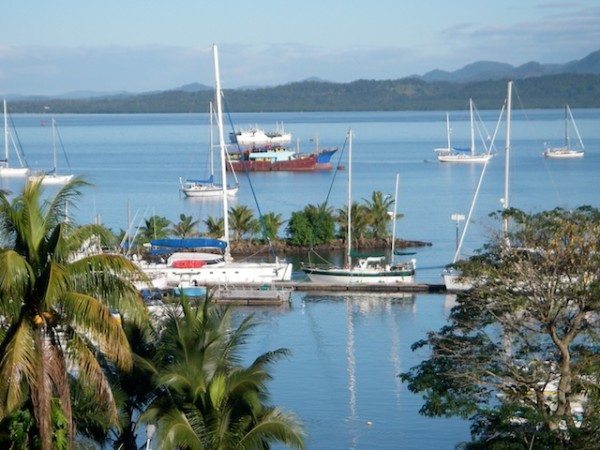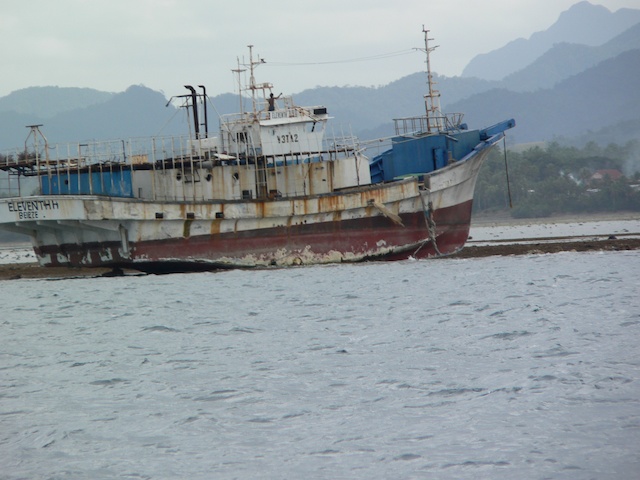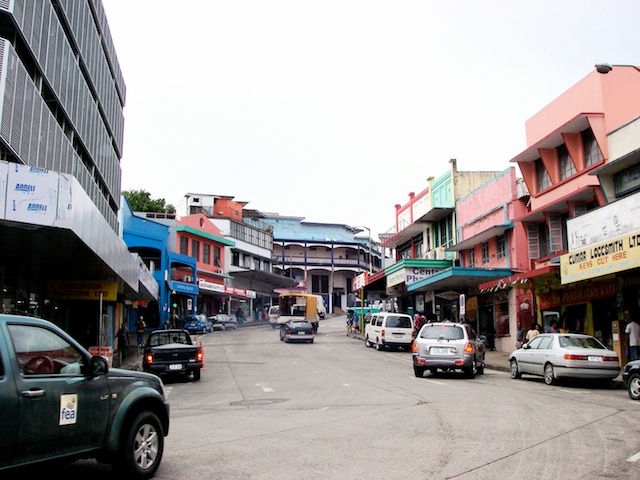Published in the Ocean Watch column, Honolulu Star-Advertiser © Susan Scott
May 5, 2014
SUVA, FIJI » Officially Fiji consists of 322 islands, but if your definition of island includes underwater atolls, coral banks and partially submerged islets, the number rises to 844. And although our nautical charts note every (we hope) island, atoll and reef, some are so small that they look like mere smudges on a map. As a result, it feels as if we’re running a giant obstacle course with our much-loved 37-foot ketch, Honu.
 Honu at the Royal Suva Yacht Club, Suva, Fiji, 2006
Honu at the Royal Suva Yacht Club, Suva, Fiji, 2006
Last week as Craig and I left Tonga, we drew our route on our GPS chart plotter to Fiji’s capital, Suva. What’s that? we wondered, squinting at a speck along our course line. When we increased the map’s scale, it showed an atoll with a central lagoon but no visible islands.
Navigating through Fiji requires vigilance today, but it’s a cakewalk compared with the pre-GPS era. As Craig and I picked our way through a 4-mile-wide pass, we recalled a story a former Ala Wai Small Boat Harbor neighbor told us about sailing in Fijian waters in the 1970s.
“I was in the cockpit one night watching the depth finder,” Park said. “In seconds the gauge went from 100 feet to 75 to 50. Before I could stop the boat, it showed 10 feet, 5, and crunch! We hit the reef.”
Park and his wife, Gloria, were lucky: The coral didn’t puncture their Fiberglas hull, and they were able to winch the boat off the reef using their anchors. Except for frazzled nerves, they sailed away undamaged.
Sailors now use GPS maps to avoid dangerous reefs in tropical waters, but even so, it’s easy to be fooled.
“Look, there’s a fishing boat,” Craig said as we skirted a safe distance from one of several smidgens of reef we found along our route.
“It looks like a lighthouse,” I said, squinting into the distance, “or some kind of navigational tower.”
“There are two separate peaks,” Craig said, when Honu drew a bit closer. “Maybe this atoll has rocky spires like La Perouse Pinnacle” (in Hawaii’s French Frigate Shoals).
We sailed on, Honu racing downwind in 25 mph tradewinds as we watched 8-foot seas hit the reef edges in big white explosions. Two hours later the identity of our mystery mounds was clear: They were two enormous ships, one wrecked on each side of the atoll.
 Wreck, coming into Suva, Fiji, 2006.
Wreck, coming into Suva, Fiji, 2006.
As we passed wreck after wreck, we appreciated more than ever the Pacific Seafarers Net, a group of volunteers who keep track of sailors via ham radio.
When underway, we check in daily with these friendly folks, two of whom are Hawaii residents. Throughout the Pacific, recreational mariners report their boat’s coordinates, sea conditions and destination. The volunteers post this information on the Internet for friends and families, and diligently monitor, and report, our safe arrivals.
When you’re no more than a minuscule piece of plankton floating past a speck on a chart, it’s great to know that someone is listening.
Fiji might not be the easiest place to navigate, but the exceptional hospitality we’re receiving at the Royal Suva Yacht Club, where we’re waiting out bad weather, makes us know that it’s well worth the effort. The reefs await.
 Suva, Fiji, 2006
Suva, Fiji, 2006